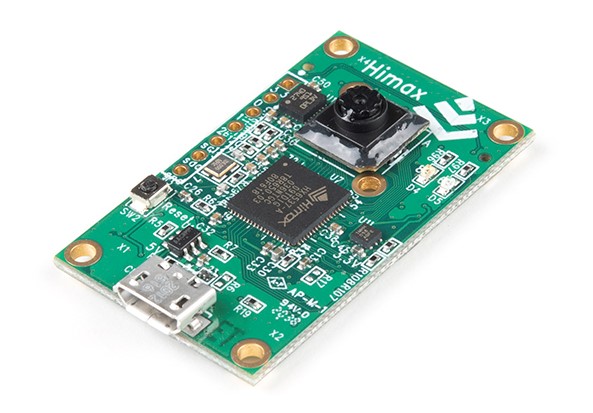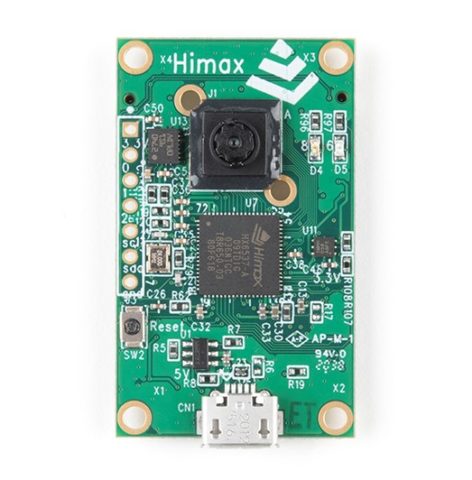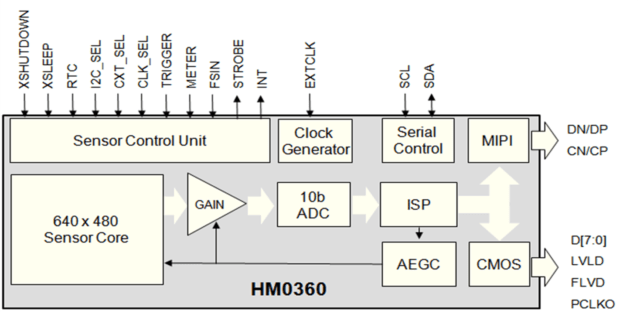Himax WE-I Plus EVB is a low-power AI development board focused on machine learning and deep learning applications with its support for the TensorFlow Lite framework for Microcontrollers. It consists of majorly two significant components. First, HX6537-A ASIC is an ultra-low-power microcontroller designed for battery-powered TinyML applications. Second, HM0360 VGA mono camera with ultra-low power and CMOS image sensing features for CV(Computer Vision) based applications like object classification and recognition.

The All in One AI Development Board
The Development Board consists of HX6537-A ASIC, with built-in ARC EM9D DSP working at 400MHz frequency. It contains internal 2MB ultra-low leakage SRAMs for system and program usage. It also contains two LEDs to display classification results. Connections with external sensors/devices can be established using I2C and GPIOs interface present in its expansion header.
“The all-in-one WE-I Plus EVB includes an AI processor, HM0360 AoS VGA camera, 2 microphones, and a 3-axis accelerometer to perform vision, voice, and vibration detection and recognition. It builds in FTDI USB-to-SPI/ I2C/ UART bridge for flash programming/interfacing and message/ debug print/ metadata output.”

Low Power AI Development Board
HX6537-A works on the interrupt-based trigger mechanism to wakeup the device from the deep-sleep mode. It additionally “provides a multi-layer power management scheme to wakeup CMOS sensors periodically for ultra-low power applications.” The hardware state machine controls this power management system and hence the trigger condition of power layer change is the result of Vision detection.
HM0360 contains a sensor that works on several monitoring options that can be controlled by the programmers by providing suitable conditional interrupts. Therefore, the host processor can remain in low power mode until the sensor triggers it.

Hence, Himax Technologies says “Himax WE-I Plus EVB is industrial leading ultra-low-power and best performance platform to fit blooming AIoT applications.” Also, “It is the best leading ultra-low-power and performance solution for TensorFlow Lite for Microcontrollers applications in this industry.”
Features
- WE-I Plus ASIC (HX6537-A) designed in ARC 32-bit EM9D DSP with FPU working with 400MHz clock frequency. It contains 2MB SRAM and 2MB Flash.
- Himax HM0360 AoS TM ultra-low-power VGA CCM with 1/6″ CMOS Sensor. Pixel dimensions of 640 x 480 Pixel with 60 FPS speed.
- FTDI USB to SPI/I2C/UART bridge
- LDO power supply (3.3/2.8/1.8/1.2V)
- 3-axis accelerometer (STM LSM9DS1)
- 1x reset button
- 2x microphones (L/R)
- 2x user LEDs
- MicroUSB connector
- Expansion header consists of 1x I2C port and 3x GPIOs
Conclusion
The low power consumption technology of the development board reduces the current requirements. This significantly improves the design by eliminating the heat factor. The ASIC optimized for DSP intensive deep learning applications makes it multifunctional to perform voice, vision, and vibration detection and recognition. The all-in-one EVB contains many inbuilt devices that make it a good option over other “high profile boards such as the Arduino Nano 33 BLE Sense and ESP32” The support for the Tensorflow Lite Microcontrollers adds an additional feature of easy deployment. In terms of performance, the latency time for the 250KB TensorFlow Lite for Microcontrollers “Person detection” example is only 40ms, while the latency time of the 20KB TensorFlow Lite for Microcontrollers “Micro speech” example is only 6ms.
Himax WE-I Plus EVB Endpoint AI Development Board is available at Spark Fun for 65 USD. More details can be found on the product page.

Saumitra Jagdale is a Backend Developer, Freelance Technical Author, Global AI Ambassador (SwissCognitive), Open-source Contributor in Python projects, Leader of Tensorflow Community India and Passionate AI/ML Enthusiast
Support CNX Software! Donate via cryptocurrencies, become a Patron on Patreon, or purchase goods on Amazon or Aliexpress




